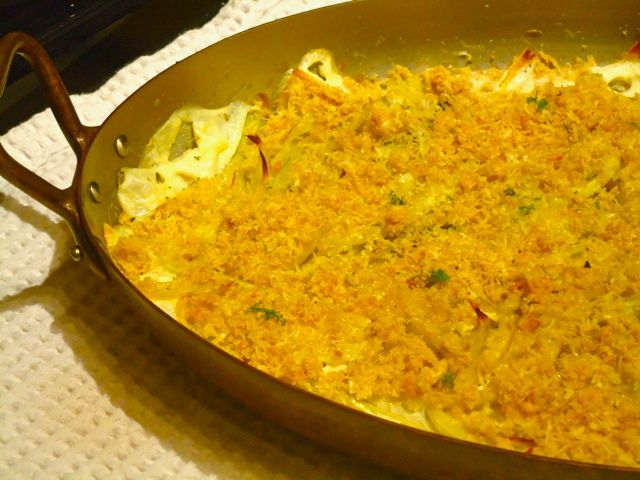
gratin, l
(article, Deborah Madison)
[%adInjectionSettings noInject=true][%pageBreakSettings nobreak=true] Gratins are all about tender vegetables covered with a golden, crusty surface. Pretty much any vegetable — but especially winter vegetables — can be baked in stock, milk, béchamel sauce, or cream, and topped, often with cheese and sometimes with breadcrumbs. [[block(sidebar). h1.Featured recipe]] Unlike the deeper casserole, the gratin dish is shallow, allowing plenty of crust (which I’m pretty sure is everyone’s favorite part) to form on the surface. Macaroni and cheese baked in a gratin dish yields much more of a crunchy topping than when it's cooked in a casserole dish. I often bake soufflés in a gratin dish instead of a tall soufflé dish for the same reason — everyone gets plenty of that golden surface. Can these be called gratins? Some would say so, by virtue of being baked in a gratin dish. But when it comes to gratins, mostly I’m thinking of vegetables. [%image reference-image float=right width=400 caption="Our crusty version of Deborah's gratin."] Gratin Dauphinois, which classically consists only of potatoes baked in cream — no cheese, no breadcrumbs — is one of those dishes that tempts a restaurant diner mightily, regardless of what goes with it. The cream forms a protective covering as it bubbles over and then reduces, turning a burnished golden-brown hue as it does so. Potatoes work with virtually all root vegetables, though I might draw the line at beets. Potatoes and leeks, potatoes and celery root, potatoes and turnips, parsnips, kohlrabi, fennel, salsify — it’s safe to say they’ll all be appreciated and completely devoured. But these same vegetables can stand alone without potatoes. Gratins usually are served with meat, but another way I like them is to place a bubbling mound of the crusty vegetables over a sautéed green — chard especially, but also spinach, kale, and even mustard greens, depending on the vegetable gratinéed. The contrast of the colors and textures is pleasing, and it brings focus to the plate. You might even consider the possibility of serving a gratin as a course alone. I think gratins make a great vegetarian dinner, too. But regardless of how you plan to serve them, they make your kitchen smell divine. A word about the breadcrumbs. If you toss them in oil or melted butter before setting them over the vegetables, they will brown better than if you skip that step. One of my favorite gratins has a topping of bread soaked in milk. It sounds and looks horrible, but it really keeps the vegetables moist while it ends up perfectly crisp. It’s the recipe for today, Artichoke, Celery Root, and Potato Gratin, a gratin that is made extra-special by the inclusion of celery root and artichoke hearts. Serve it so the crust stays on top. It's a somewhat elaborate but nonetheless easily made dish.

gratin, l

reference-image, l

newsletter-image, l